QNAP QSW-2108-2C 10Gbe & 2.5Gbe Managed Switch Hardware Review
The full range of QNAP network solutions is certainly expanding fast! Staying on top of their new releases outside of NAS has been quite a rollercoaster and with newer managed switches on the way, new NAS+Switch combos and even a growing range of Wifi 6 and mesh solutions on the schedule, they are really evolving into a network ‘swiss army knife’ of a brand. Today I want to talk about their new affordable managed switch that joins their affordable/value tier, the QNAP QSW-M2108-2C. This new switch serves as a viable alternative/3rd choice for home and business buyers who are looking at buying their first switch (or upgrading from a basic brainless box) towards something that has a lot of bandwidth, a lot of futureproofing, but does it without breaking the bank. Obviously, the current trend of affordable 10Gbe would be the ideal choice for most, but with 10Gbe still arriving at a price tag some 4-5x that of 1Gbe (which is still pretty affordable compared with 5yrs ago), the scaling between a 1Gbe switch and a 10Gbe upgrade is still arguably vast for the budget-conscious. THAT is exactly where the QNAP QSW-M2108-2C comes in (they claim!) with 8 2.5Gbe ports (so each one is 2.5x the bandwidth/speed of traditional 1Gbe RJ45), as well as arriving with 2 possible 10Gbe ports – a potential 40Gb/s overall of network transmission to share. Along with a low energy footprint, a choice of fiber/copper connectivity at the higher connections and all this whilst being completely layer 2 security managed – is just seems too good to be true. The price tag at £250+ (without your local tax) manages to be both high for home users, yet remarkably cheap for even small business users. So, does the QNAP QSW-M2108-2C network switch deserve a place in your network architecture? Let’s find out.
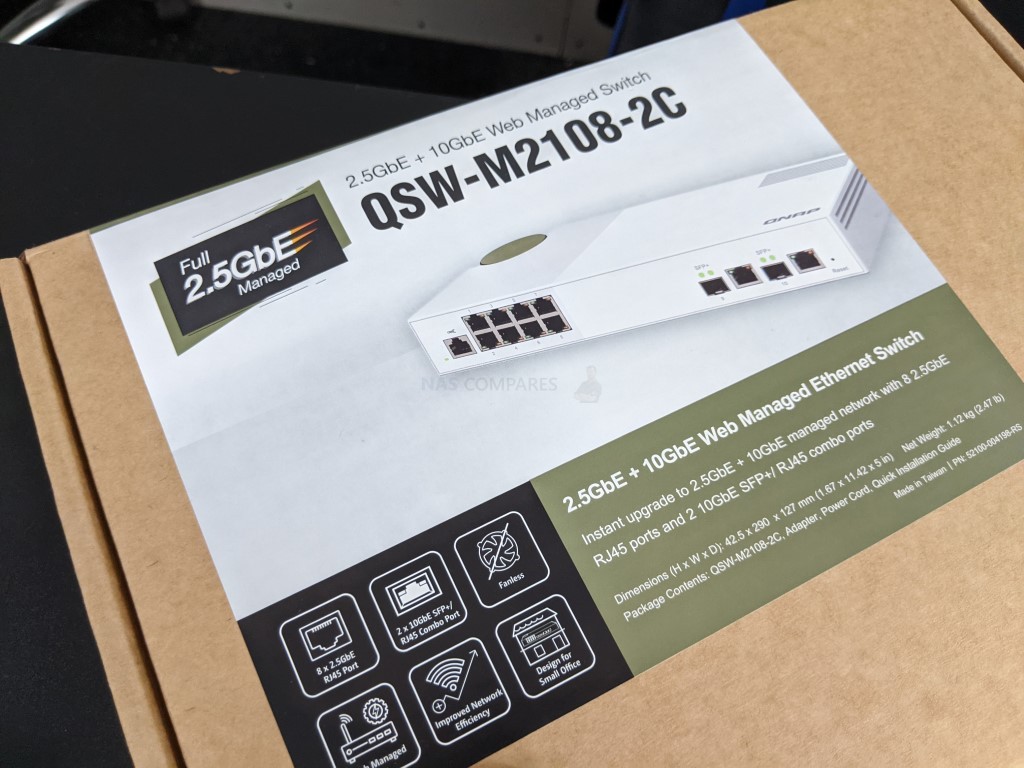
QNAP QSW-2108-2C Review – Quick Conclusion
There is always going to be the question of “who actually has 2.5Gbe these days?”, which is a perfectly valid point! The answer is that thanks to the growth of WiFi 6 (802.11ax) we are seeing lots of router solutions arriving with 2.5G ports. That’s not all though, there are several USB-to-5Gbe and USB-to-2.5Gbe adapters in the market that serve as much MUCH more affordable (and far more convenient) alternatively to hardware systems upgrading to 10Gbe via a PCIe card. Lastly, some more compact systems (Raspberry Pi, MacBook, ChromeBook, Laptop, Surface Pro, etc) do NOT have the ability to upgrade their network port conventionally. So, given that to date, there is no 10Gbe-to-USB adapter on the market (and if there was, I would look at Aquantia in the future), the only alternative to break out of 1Gbe bottlenecks is to use 2.5/5G USB adapters – which is EXACTLY why this 10Gbe and 2.5Gbe network switch exists! QNAP was not one of the first to introduce a budget +Gigabit ethernet switch in 2020/2021 and given the affordability of 10Gbe, as well as the need for businesses to improve their internal networking speeds to match that of high-end ISP and fibre internet around the world, they likely will not be the last. However, the combination of 8x 2.5Gbe with the 2x10G really makes the QSW-2108-2C managed switch really stand out, whilst still arriving in a compact and affordable way – a scaled 10Gbe switch for businesses that want to make the step towards this network bandwidth, but is still unsure about the investment. With its unique multi-port combo system, allowing users to combine copper and fibre environments, there is a large degree of flexibility even at this more affordable price point. The design is not for everyone and it lacks the lifetime warranty of some more expensive NETGEAR solutions, but the QNAP QSW-2108-2C is most certainly a capable solution and manages to live up to every single promise that QNAP claims. Along with an incredibly intuitive management panel and ease of design that lends heavily from the QTS NAS software, it certainly beats most of its competitors in the GUI department. In short, the QSW-M2108 largely defeats any notion of looking at 1Gbe switches ever again…
QNAP QSW-2108-2C Review – Packaging
Let’s get the dull stuff out the way – the retail box! The first two things that struck me about this network switch when I first got my hands on the retail box was 1, the box is incredibly small to contain a 10 Port managed network switch, especially given that it technically has 12 ports. The second point was that it seemed heavier than I expected for the size. Arriving in a very similar retail box to that of the unmanaged version released almost 2 years ago, it still provides plenty of information and protection, though fewer layers of physical protection than the majority of their NAS range, this is to be expected on this scale. A little bit of that extra weight is likely down to the inclusive internal fan that is absent in unmanaged versions.
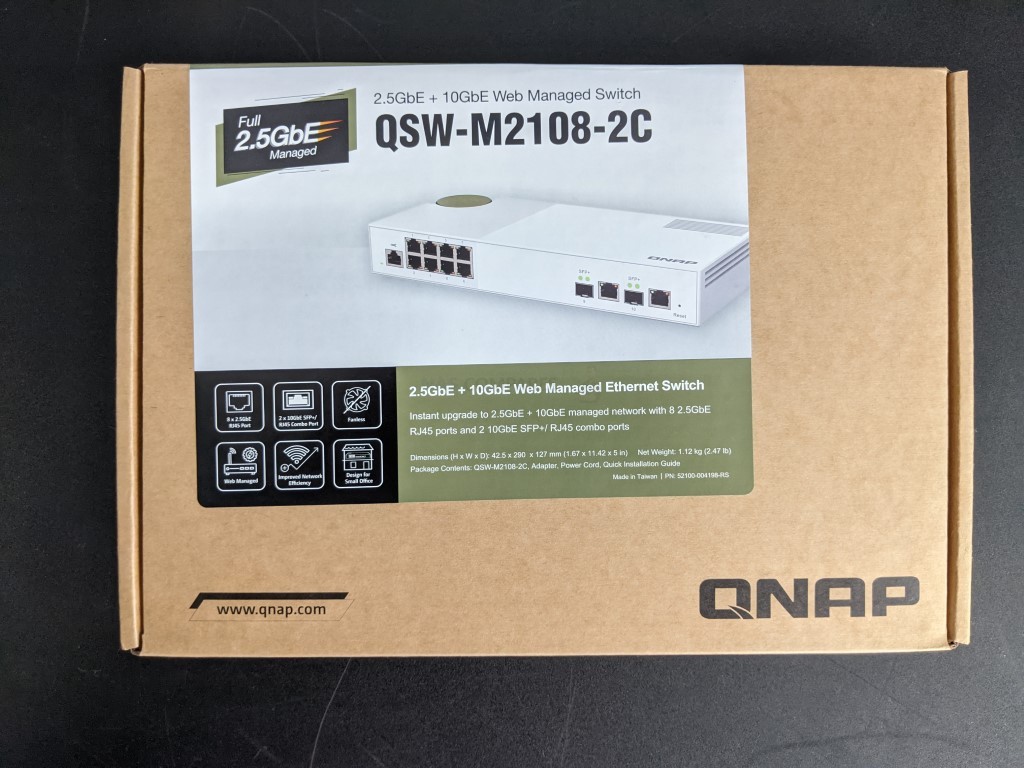
Opening up the retail box shows us the full switch and a small partition for the accessories that this switch arrives with. They have certainly managed to pack it all in tightly and I can totally imagine this box appearing on the shelf of your local electronics store for display.
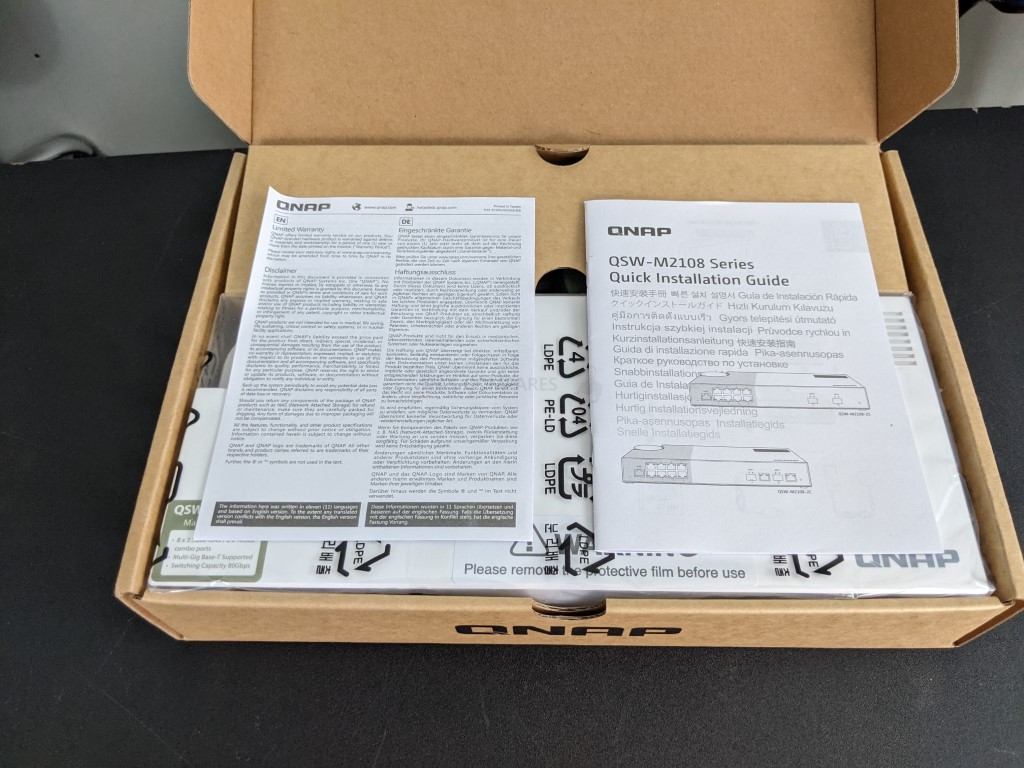
Opening up the accessories box provides us with the QNAP QSW-2108-2C switch and very few accessories. Network cables are not included with this which, which is fairly standard in this kind of technology as it is assumed that any device that requires cable connection to the switch will already arrive with said cables. There is also information for first-time setup and deployment, as well as information on the 2-years of manufacturer’s warranty that it includes. However, a rather interesting point surrounds the PSU.
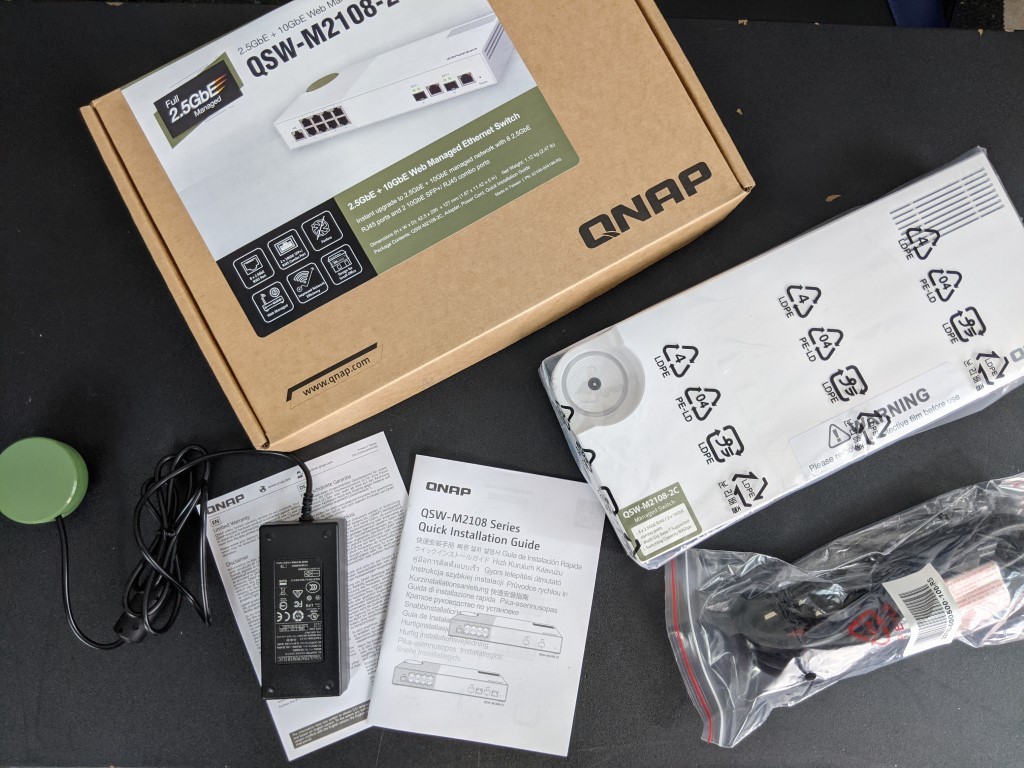
The power supplier included with this affordable managed 2.5G and 10G switch is an external rotational PSU that fits in it a unique way to the rear of the switch casing, with it being rotatable as needed. The low power PSU that the QSW-2108-2C arrives with is designed so that despite its external connectivity, it does not hamper the QSW-2108-2C being installed and deployed in remarkably compact environments. We have used the unmanaged version of this switch in the YouTube study for over 2 years and it’s quite a compact environment, so the scale of this regularly used chassis by QNAP is a plus from us.
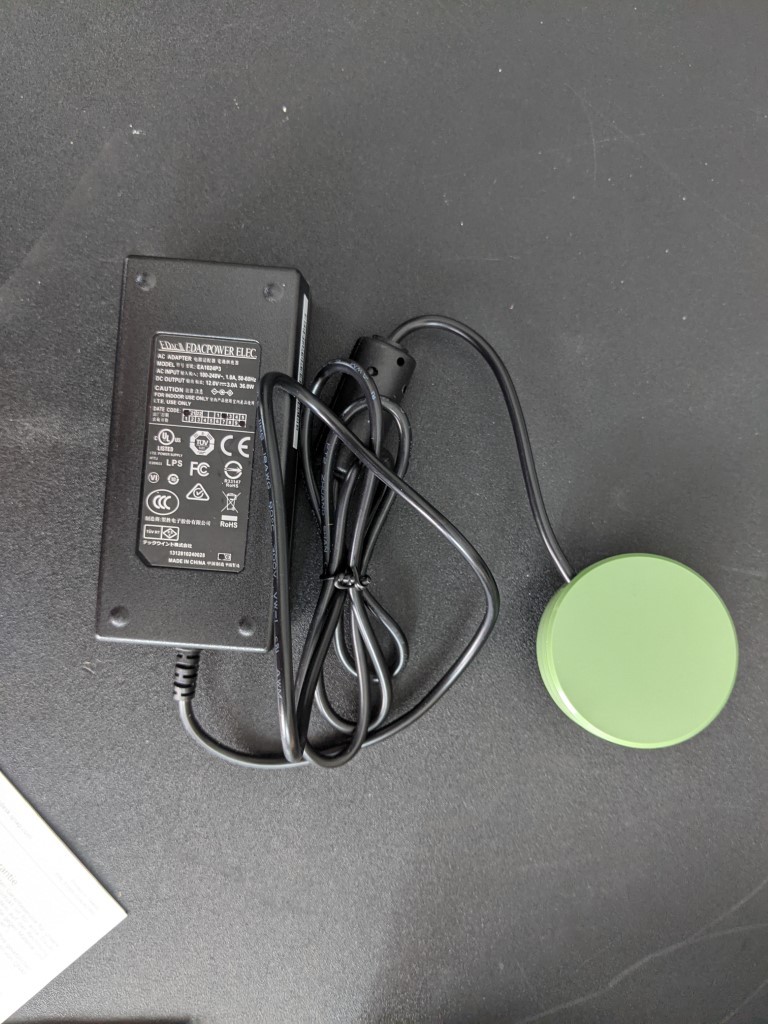
I have not encountered many 10G switches that feature external power bricks, even small ones like this, but I quite like the idea, especially given the fact this switch still typically uses considerably less power than most 10G combo switches in its price range. That said, this IS only marginally more 10Gbe equipped (4 ports in a 2×2 combo arrangement) and the power for the 2.5Gbe x8 (even though they are 2.5x greater bandwidth than traditional 1Gbe) is not going to be massive, with a reported 12.17W power consumption reported at full use.
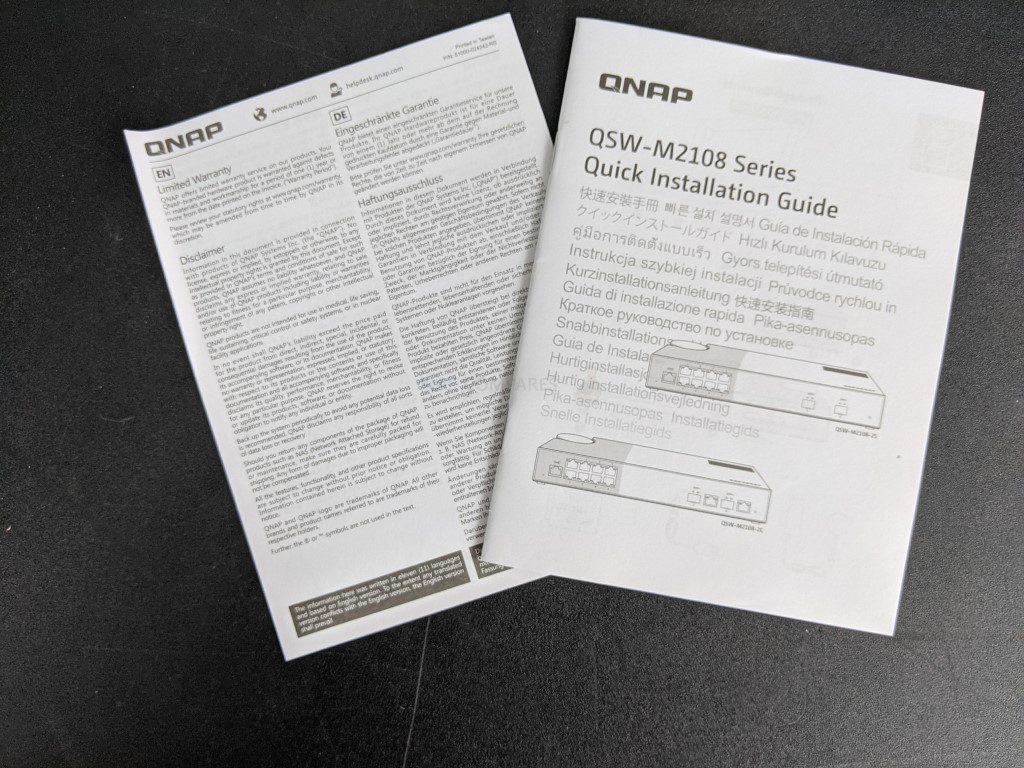
Overall I can’t say that the accessories included with the QNAP QSW-2108-2C affordable switch, though not are exactly mind-blowing, are still pretty much everything you’re going to need to convert your existing 1Gbe network into a higher scale 2.5Gbe and streamlined 10Gbe equipped environment are all here. That warranty is still a little shorter than I would like though, even at just £250+ without the tax.
QNAP QSW-2108-2C Review – Design
You immediately know when looking at the design of the QNAP QSW-2108-2C 10Gbe switch that the colour and shape are going to divide the audience. Arriving in a narrow white vented plastic casing with the blue rotational PSU on the rear, it does have somewhat of a budget aesthetic.
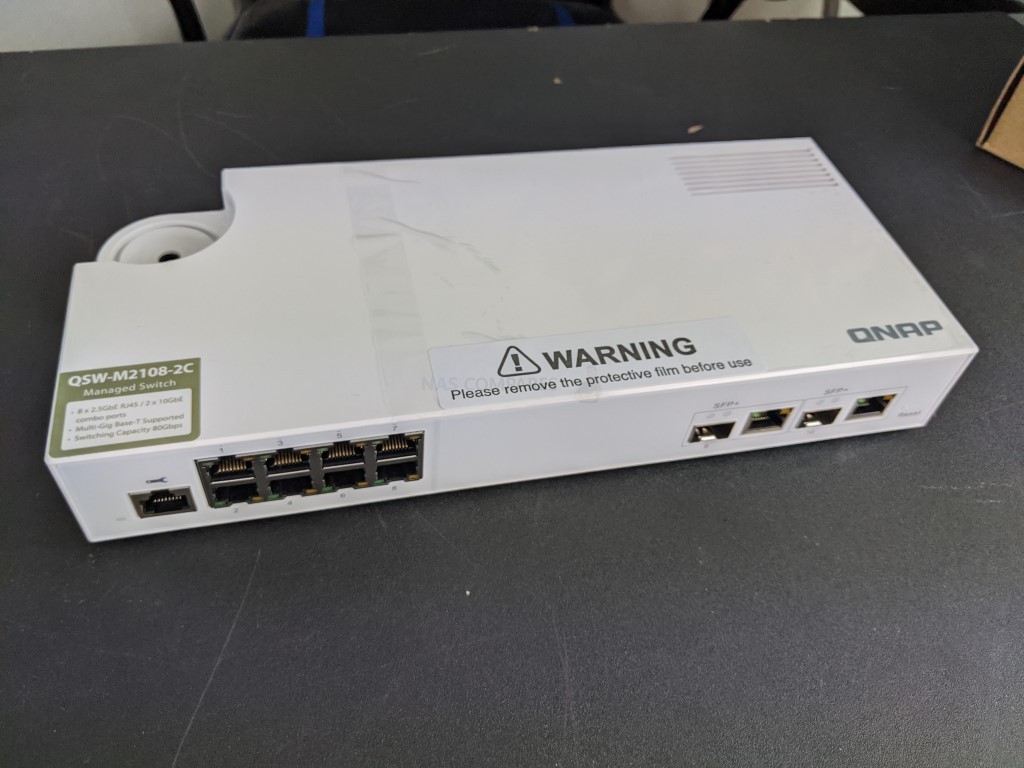
However, it uses the same general casing as the unmanaged version originally revealed back in 2019 and despite that white and plastic external look, many users have told me that it does lend a certain uniformity to small editing suites that are stark modern and well lit. I personally prefer the black metal casing of the more expensive unmanaged first-generation switches, but we are all different.
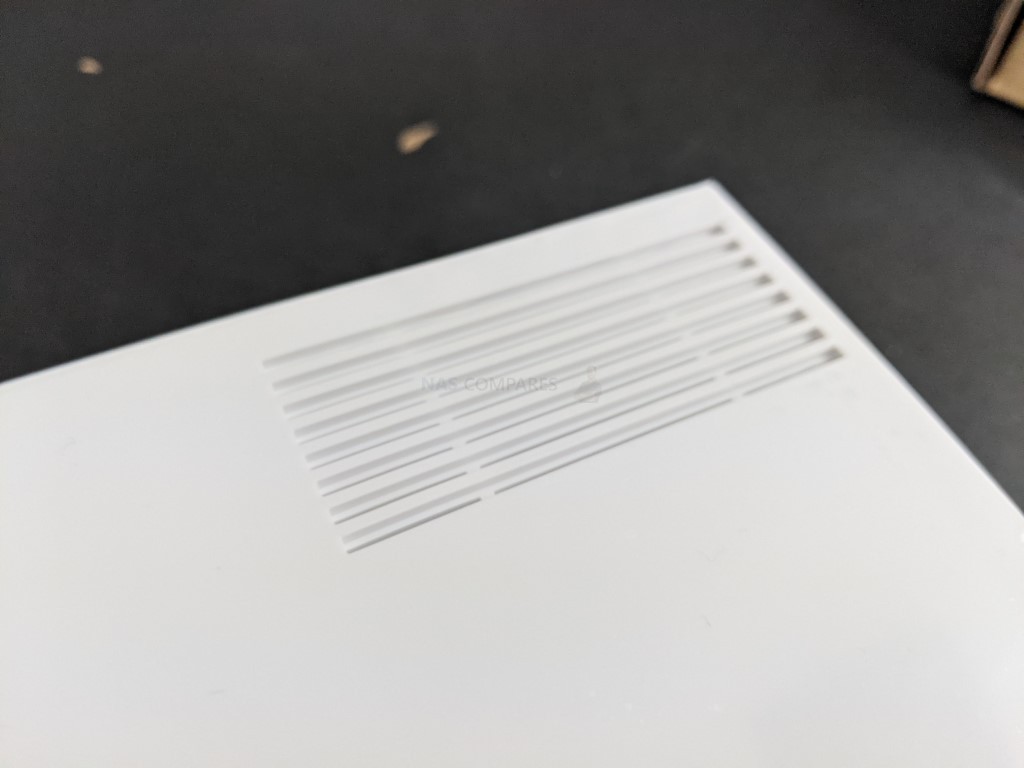
Another core buying point for the QNAP QSW-2108-2C is with regard to how the device maintains cool internal temperatures. The internals of the QSW-2108-2C is almost exclusively silent heatsinks over key areas of the internal PCB, as well as a single PWM double ball bearing fan. The majority of cooling only QSW-2108-2C is achieved simply from tactical ventilation on all sides of the casing that allow cool air to travel over the internal heat sinks with assistance from that small fan. Even when I had several devices connected to this switch during my software video testing (coming soon) it barely made any noise.
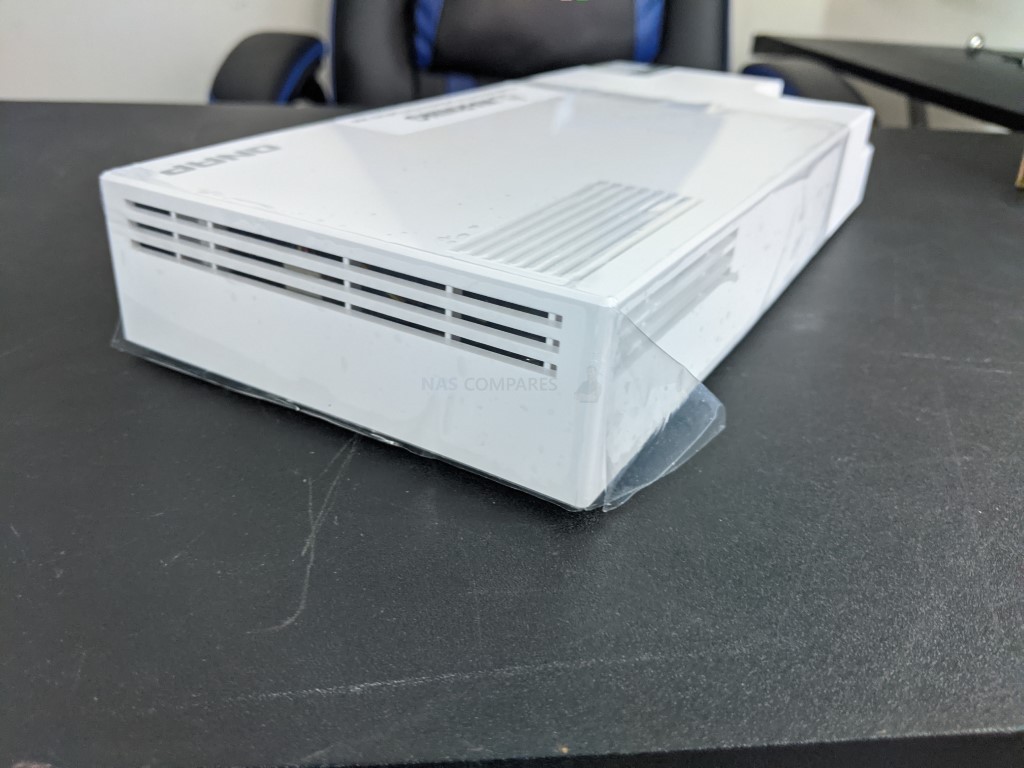
Despite the near-certain fact that any switch that features 8/12 ports (especially if some of those ports are 10Gbe) and noise is near enough unavoidable, you can see that the QSW-2108-2C has managed to avoid this by both having discrete internal cooling systems and ensuring that the PSU is outside of the chassis. That means that this switch can easily sit on your desk and connecting multiple devices, or allows you to edit directly on a 10Gbe NAS, (or higher with link aggregation) comfortably and whilst easily blending into the environment.
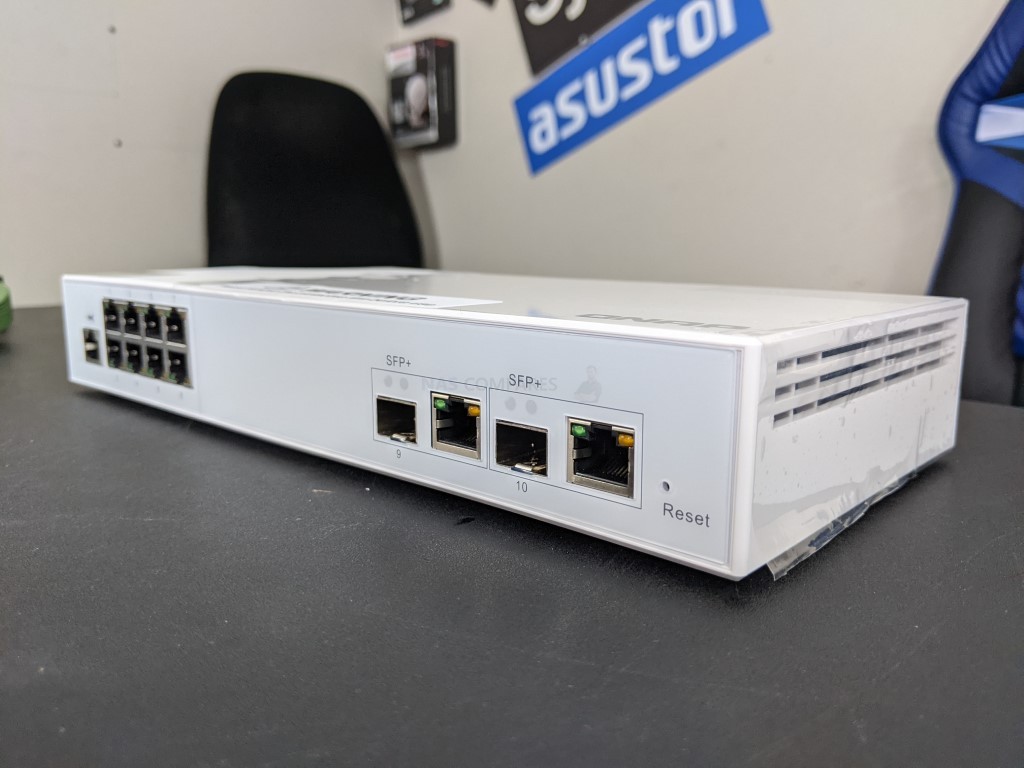
As mentioned, the QSW-2108-2C features support of both 2.5Gbe and 10Gbe connections. The dedicated 2.5GBASE-T ports are all RJ45 copper-based and are grouped together in a form of eight at the front. The management, control, configuration and monitoring of these ports is shared by the same GUI and software as the 10Gbe connections. Each port supports up to 250MB/s and can be linked aggregated as needed, as virtual networks (vLANs) be created as sub-networks as needed. There is an additional config network port located on the switch for connecting too third-party monitoring devices and maintenance. Most users looking at a switch at this price point will rarely take advantage of this feature but it’s still a nice touch that it is included. With link aggregation/Load Balancing, there is the potential for a shared 20GB/s network bandwidth across these ports.
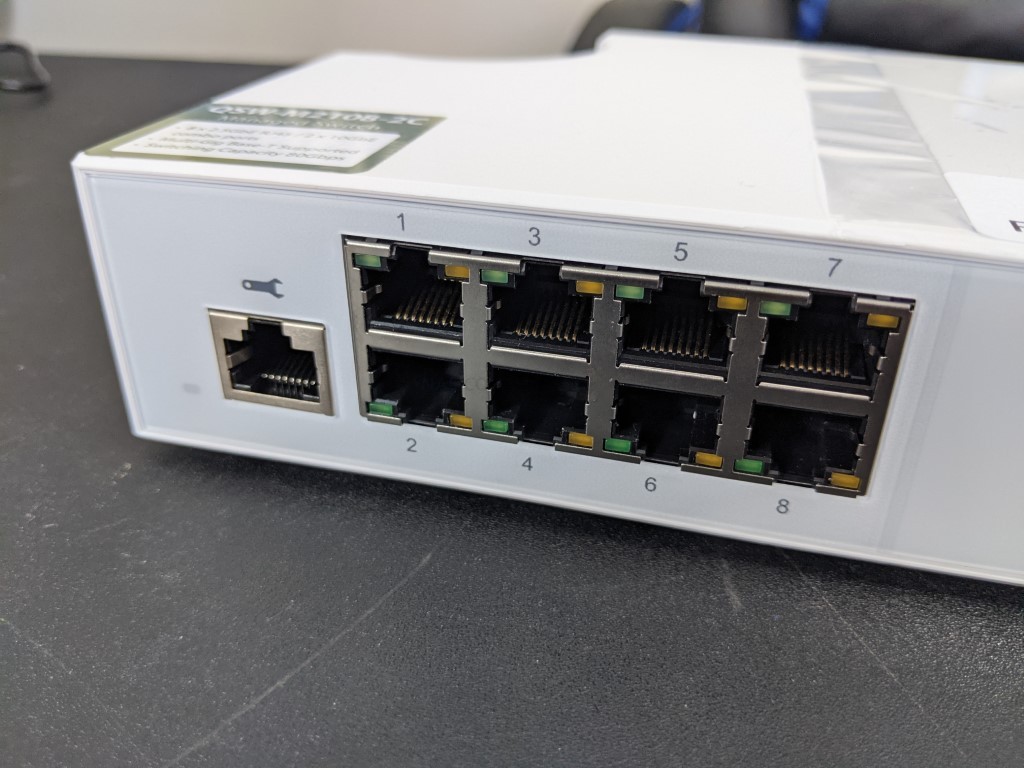
And now onto the key selling component of this device, the 2x 10 Gigabit Ethernet ports located on the front right of the case. There are a total of 4x 10Gbe ports available, however, it is worth noting that these ‘combo’ ports are designed to allow the pairing of 1x 10Gbase-T copper and 1x SFP+ fibre-based 10Gbe connection each. You cannot use all 4-port independently, but you can link aggregate each pair of 10Gbe ports to allow up to 20Gbe per combo. This brings the total available shared bandwidth across the switch ports to an impressive 40Gb/s (4,000MB/s)
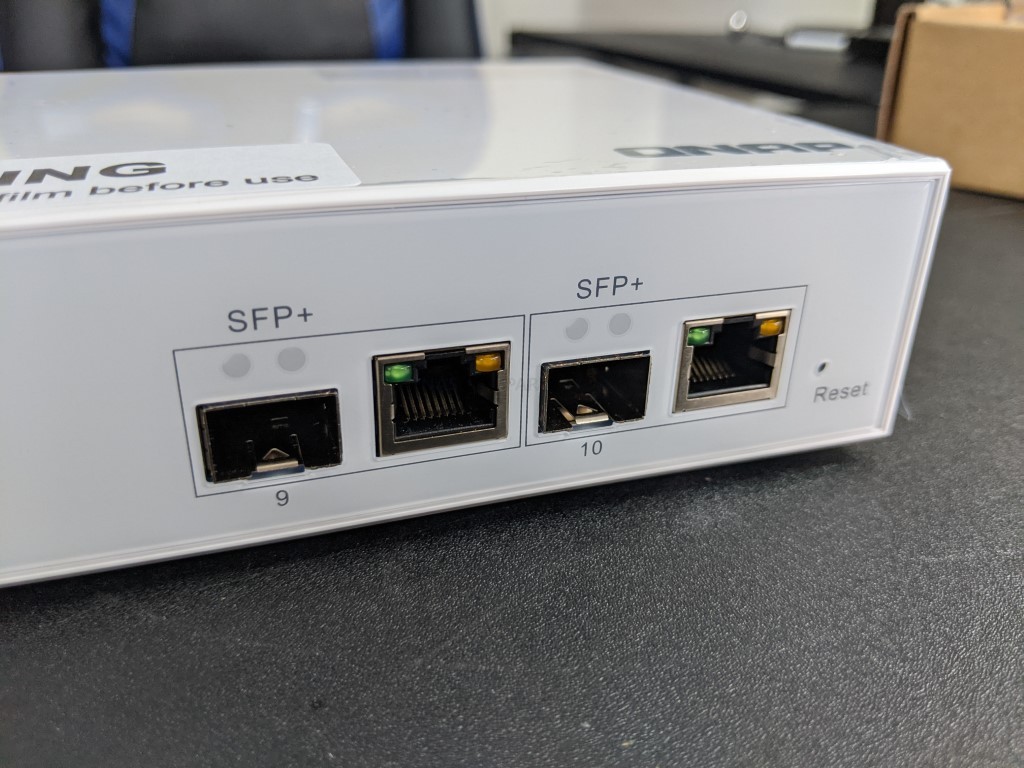
Originally, this design choice is to allow the far-reaching long-distance advantages of fibre-based 10Gbe (SFP+) to connect with the localised internal networking and affordability provided by copper-based Ethernet (RJ45). However, you can purchase moderately inexpensive SFP to 10Gbe adaptors that allow you to convert these port into copper ports and utilise them all internally. This will increase the price noticeably and likely to push the price point of the QSW-2108-2C closer to that of a more enterprise-grade solution that may well negate the adaptors entirely, but on a smaller scale you can still get away with one or two, whilst still saving some money.
The utility of the combo environment of this managed switch is two-fold. First, as mentioned, this allows you to create an affordable bridging point between faster external and faster internal cabling and create abridged environment between them, which is great for companies with office locations that are regionally close but generally quite far apart. The other use for this kind of technology is to allow the use of SFP 10Gbe solutions in your network environment, many of which are available from QNAP in similar affordable ranges. Though it is, of course, worth highlighting that although SFP network devices are generally more affordable, the cabling and transceivers required for a fibre network are noticeably more expensive in the long run.
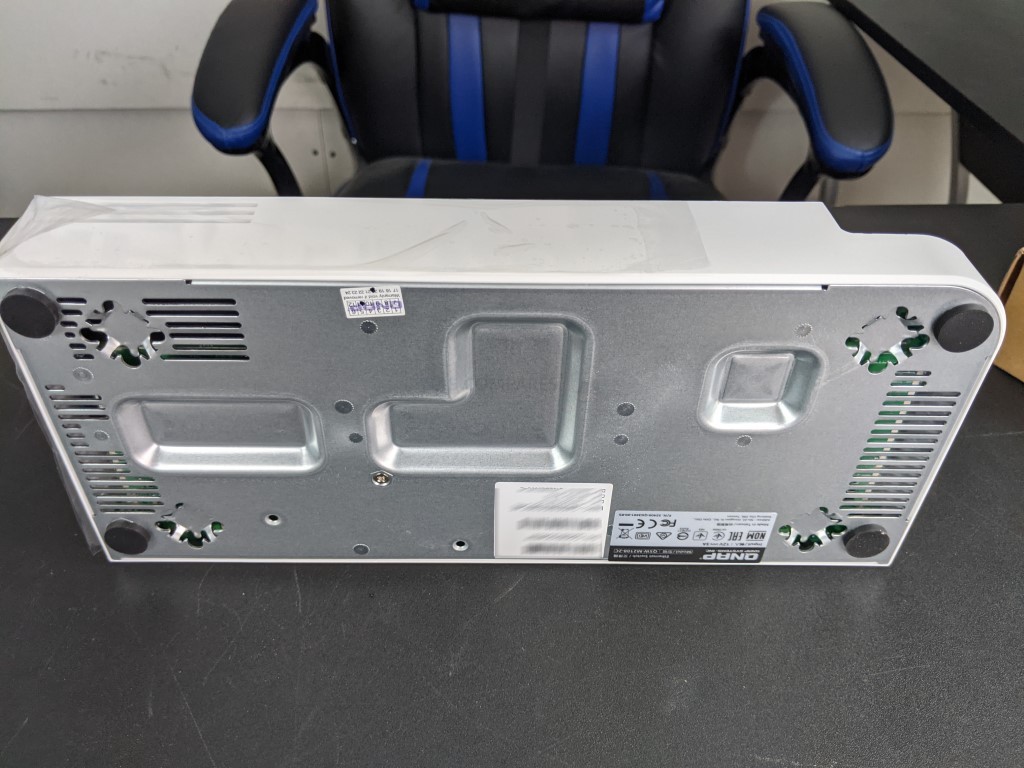
The base of these network switch is fairly plain, metal exposed and features rubberized feet to elevate the device a few millimetres from the desktop. There is another last bit of ventilation, but apart from that, the QNAP QSW-2108-2C is a fairly compact and well-contained network switch. Now let’s talk about the software and management options of the QSW-2108-2C.
QNAP QSW-2108-2C Review – Software
Despite its rather modest price tag, the QSW-2108-2C does have a number of unique and desirable features typically found at the much higher price point or from network titans like NETGEAR. It arrives equipped with Layer 2 management functionality (e.g., LACP, VLAN, ACL and LLDP) using a comprehensive, yet simple, Web GUI that is incredibly familiar to anyone that has utilised a QNAP NAS previously, as well as being a far cry of the rather dated NETGEAR genie GUI still found in a number of modern solutions. This will give users network bandwidth control and enhanced network security. In total, the switching capacity of QSW-2108-2C is 80Gbps, maximising out the full potential of each port. The QNAP Switch System (QSS) provides an overview dashboard, port management and setting guide to help administrators control Layer 2 networks. It features:
- Real-time system information, port connection status and port traffic
- Powerful security and system functions (including ACL, LLDP, RSTP and Flow Control) to help administrators enhance network reliability
- An overview of port status, port packet statistics, and configure port speeds.
- Bandwidth and packet control functions (such as LACP, VLAN, QoS, and IGMP Snooping) for boosting network performance through IP grouping and bandwidth management.
- One of few web-managed switches that support Rapid Spanning Tree Protocol (RSTP). You can easily and efficiently deploy small/medium-scale networks that support expansion, redundancy and loop prevention.
It provides all of these features, as well as the ability to create multiple virtual networks within the main core network, and even features automated or manual firmware update that is a far cry easier to implement than a number of network switches I have used in the past. There is quite a few pop-up guides included too for the network novice, perhaps a little too many times (if you know your way around, they can get pretty annoying actually), but everything is explained quite easily and I feel there is a good balance between being user-friendly and not too dumbed down. Alternatively, you can always just plug and play the device to work straight out of the box, as no prior network configuration needs to be set and the device’s default settings are more than enough to have a mixed and capable 10Gbe and 2.5G ethernet environment on day one.
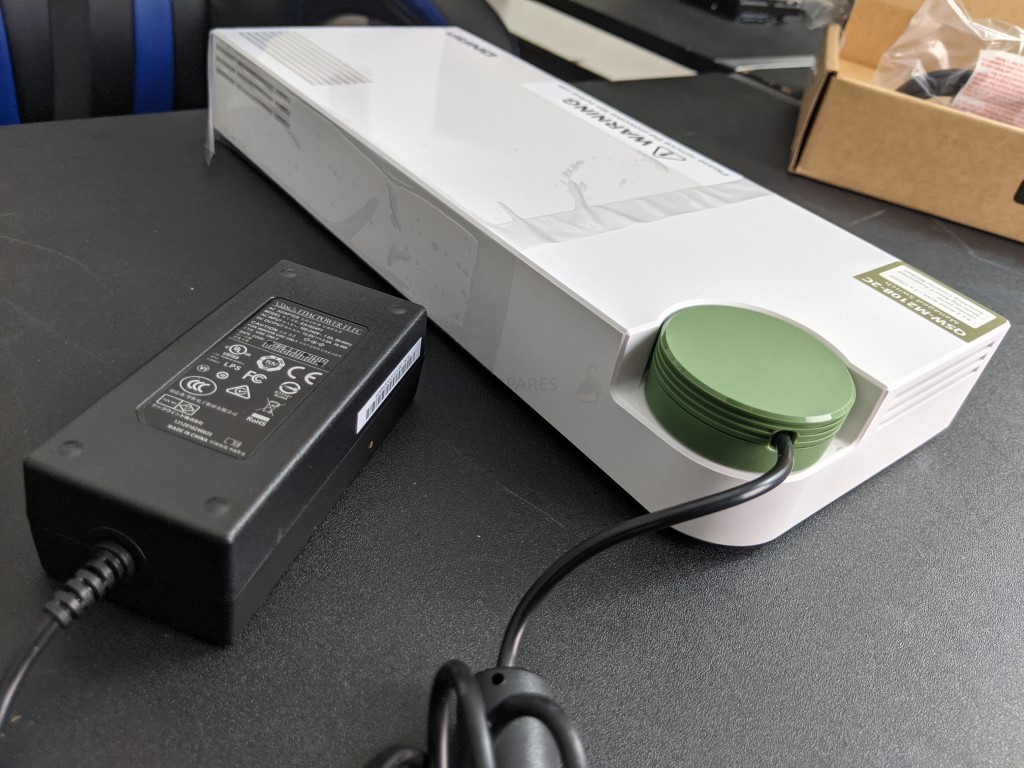
QNAP QSW-2108-2C Review – Conclusion
As odd as it may sound, I am genuinely surprised how much I like the QNAP QSW-2108-2C switch. I knew it was a good solution, as this is not the first time I have handled the QSS software from QNAP (near identical utility as found in the QNAP Guardian NAS+Switch Combo QGD-1600P earlier in 2020) but it is genuinely a very impressive and compact solution and really challenges the idea of how much a solid and reliable 10 Gigabit ethernet switch is supposed to cost in 2020. 10Gbe, as a business and home choice, is something that has been reducing in price all the time, but there have always been key elements in the equation for buyers (such as the switch and the client devices that have always lagged behind).
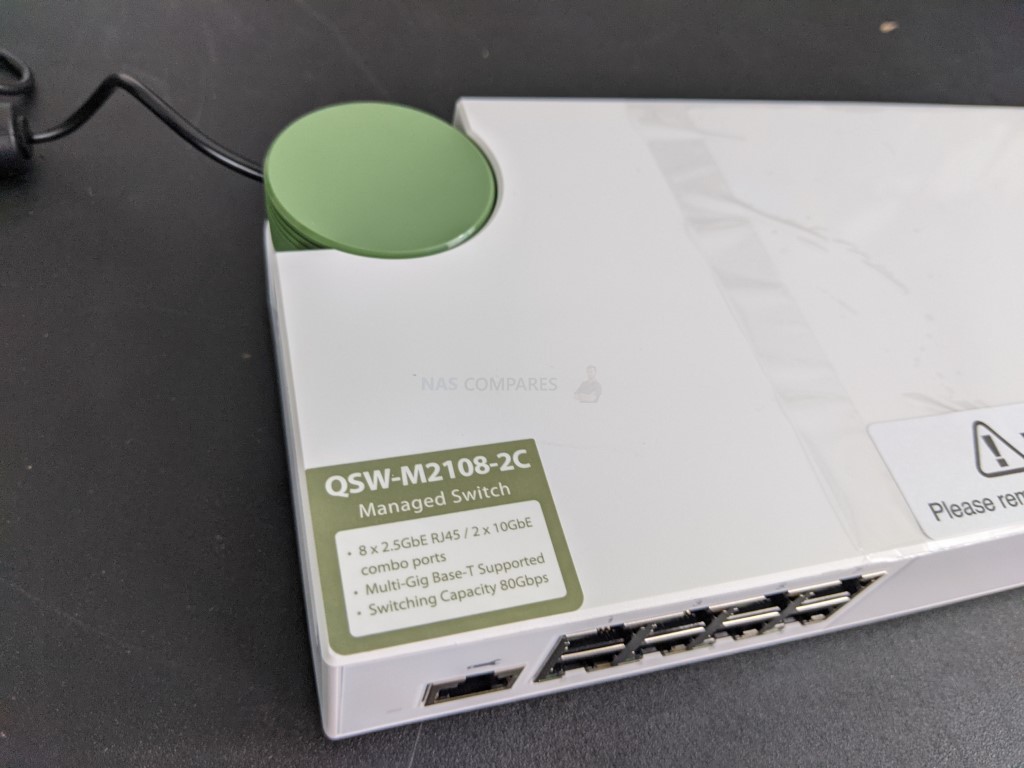
If you like, or can at least get over, the plastic white chassis that the QSW-2108-2C arrives with, what you’ll find is easily one of the best value you and software rich, low-level 10Gbe equipped solutions around right now. Extra points to QNAP for managing to make a software user interface for a 2.5Gbe and 10Gbe switch that doesn’t make most users want to pull their hair out – almost for that reason alone I bloody love this thing. Finally, there is always going to be the question of “who actually has 2.5Gbe these days?”, which is a perfectly valid point! The answer is that thanks to the growth of WiFi 6 (802.11ax) we are seeing lots of router solutions arriving with 2.5G ports. That’s not all though, there are several USB-to-5Gbe and USB-to-2.5Gbe adapters in the market that serve as much MUCH more affordable (and far more convenient) alternatively to hardware systems upgrading to 10Gbe via a PCIe card. Lastly, some more compact systems (Raspberry Pi, MacBook, ChromeBook, Laptop, Surface Pro, etc) do NOT have the ability to upgrade their network port conventionally. So, given that to date, there is no 10Gbe-to-USB adapter on the market (and if there was, I would look at Aquantia in the future), the only alternative to break out of 1Gbe bottlenecks is to use 2.5/5G USB adapters – which is EXACTLY why this 10Gbe and 2.5Gbe network switch exists!
| PROS | CONS |
|
|
If you are thinking of buying a QNAP NAS, please use the links below
🔒 Join Inner Circle
Get an alert every time something gets added to this specific article!
This description contains links to Amazon. These links will take you to some of the products mentioned in today's content. As an Amazon Associate, I earn from qualifying purchases. Visit the NASCompares Deal Finder to find the best place to buy this device in your region, based on Service, Support and Reputation - Just Search for your NAS Drive in the Box Below
Need Advice on Data Storage from an Expert?
Finally, for free advice about your setup, just leave a message in the comments below here at NASCompares.com and we will get back to you. Need Help?
Where possible (and where appropriate) please provide as much information about your requirements, as then I can arrange the best answer and solution to your needs. Do not worry about your e-mail address being required, it will NOT be used in a mailing list and will NOT be used in any way other than to respond to your enquiry.
Need Help?
Where possible (and where appropriate) please provide as much information about your requirements, as then I can arrange the best answer and solution to your needs. Do not worry about your e-mail address being required, it will NOT be used in a mailing list and will NOT be used in any way other than to respond to your enquiry.

|
 |
Minisforum N5 NAS, 6 Months Later - Better, Worse, the Same?
Beelink ME Pro NAS Revealed
Best SOLID STORAGE NAS of 2025
Should You Worry About the NanoKVM Hidden Microphone?
Best Cheap NAS of 2025
Minisforum MS-02 Ultra - WHO IS THIS FOR??? (The First 48HRs)
Access content via Patreon or KO-FI





Discover more from NAS Compares
Subscribe to get the latest posts sent to your email.


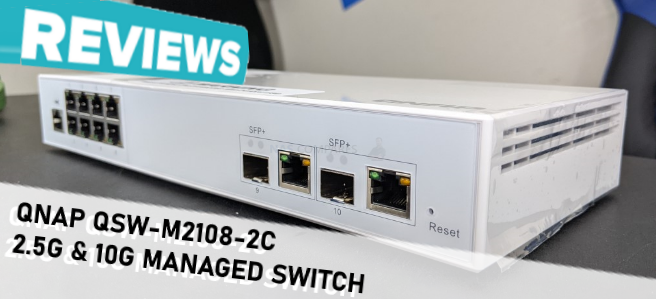




My question is which is more efficient/faster/reliable for converting between 10GBase-T and 10G DAC :
(a) A 10GBase-T cable plugged into an SPF+ transceiver then plugged into a cage on a multi-cage 10Gb switch? or
(b) A 10GBase-T cable plugged directly into a *_dedicated_* 10GBase-T / SPF+ media converter?
It would seem that the dedicated media converter *_should_* win every time, as it has no MAC address lookups to make; it’s simply what goes in one port has to come out the other. But I know of no actual testing data or empirical evidence to support this. My reason for asking is that our company just got AT&T 5Gb/s service that comes in over the infamous BGW320’s Ethernet port. But our gateway has a 10Gb/s SPF+ primary WAN port. Some Ethernet transceivers work in this port, while others do not. But even the ones that work get very, very hot very fast. I worry that they may one weekend blow a gasket, brining down the company’s high-speed connection.
REPLY ON YOUTUBE
very nice! (3 years later, of course, it would be very nice if the 8 port cluster of RJ45 connectors were of the 2.5 GbE variety)
REPLY ON YOUTUBE
whats the config port actually used for?
REPLY ON YOUTUBE
i din’t get it right with the vlan. Someone can help? I’m using a asus router, this switch in the video and a 4 port nas. My nas don’t catch up the dhcp with a vlan tag.
REPLY ON YOUTUBE
Does anyone know if two M408-4C switches can be stacked?
REPLY ON YOUTUBE
Sorry if I missed this in the video but can two of these switches be daisy chained to expand the number of ports? If so, is there a practical max “fan-out” on how many of these can be joined together before it’s better to just buy say a 16 to 48 port switch? I just bought this switch and I LOVE it!! But I’m not sure what the future holds for my home network which has a basement for music and video production (with iso booths, etc).
REPLY ON YOUTUBE
The most important reason to get managed switch is the possibility of configuring vlans. In practise you can for example connect one 10gb cable to your storage server and have two networks going trough it, one with stricter autenthication and one public. Or you can connect your wireless network trough this switch without letting anyone access (or hack) wired network over wireless.
10gb nics are very expensive, so expensive in fact that this switch can be cheaper than two nics
REPLY ON YOUTUBE
Im sorry, im new to networking. I have a noob question. Could i use this managed switch as my router? Can it connect directly to the ONT from the ISP? I guess my question boils down to “does it have a WAN port?”
Sorry for the stupid question but im just trying to learn networking.
REPLY ON YOUTUBE
Great video however I just want straight 10gig ports I’m not interested in a combo port. IMO you are better off going with the Microtik CRS309-1G-8S+IN now if you only need 4 ports this is a good buy.
REPLY ON YOUTUBE
I just bought this switch used on Amazon for $252. 😀
REPLY ON YOUTUBE
My fiber connection into my home enable me to get 10 Gbit up and downstream with talk of 100 Gbit coming in a few years. I just upgraded my 500/500 to 5000/5000 though and will see how long that keeps me happy.
REPLY ON YOUTUBE
20m range? Wtf. Try 100m
REPLY ON YOUTUBE
Hey man thanks a lot for having taken the time to make these videos and leaving them out there! Always come in very handy! I appreciate you, and hope you’re doing well! 🙂 <3
REPLY ON YOUTUBE
Can The 10Gb port also do a 2.5Gb? I tried this but I couldn’t get it to work. I tried this on Auto and set it to 2.5Gb but the lights didn’t come on on the back. (Yes the port was enabled) I was wondering if I was doing something wrong?
REPLY ON YOUTUBE
Hello.
Thank you for the numerous tests of 10Gb switches.
I have heard about some issues regarding switch speed between SFP+ ports and RJ45 10Gbe ports.
Did you make tests in this configuration? Did you notice any performance issue?
If you have already mentioned it, just refer to the article or video, I mays have missed it.
Best regards and thanks for your work.
Maurice